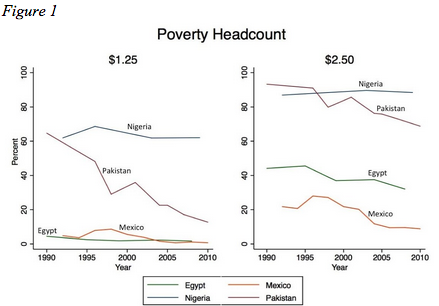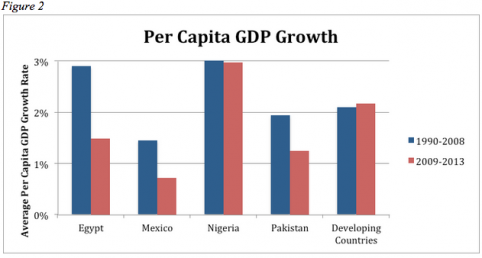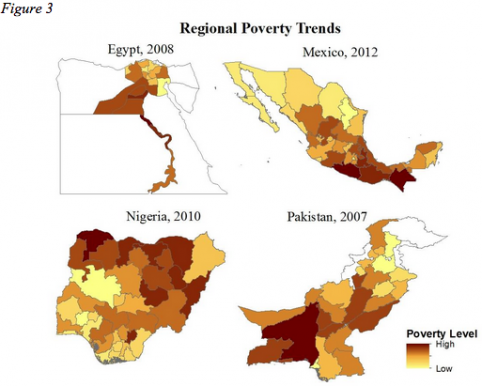“Generalizations across country experience are never easy, but one factor that is likely to matter in many developing countries is the geographic and sectoral pattern of growth.”
In 1990, over two-fifths of the developing world’s population lived in extreme poverty (less than US$1.25 a day). By 2010, this number dropped to 19.1%, achieving Millennium Development Goal One of halving extreme poverty. Driven by this success, the global community has now set more ambitious poverty reduction goals—with both the World Bankand Sustainable Development Goals aiming to eliminate extreme poverty by 2030.
The MDG-era has shown that growth—and growth that benefits the poor—will be key to achieving the 2030 goals. But the last 15 years has also shown that trends in growth, poverty reduction, and the link between the two have varied widely among countries. As such, it is important to learn from the experiences within individual countries to inform future poverty reduction strategies. I’ve chosen to analyze four countries—Egypt, Mexico, Nigeria, and Pakistan—all emerging economies that collectively make up about 10% of the developing world’s population and account for over 12% of the world’s extreme poor.
I summarize four key lessons, which collectively point to the need to look beyond the usual metrics—beyond the $1.25 poverty line, beyond aggregate indicators of growth into both sources of growth and subnational growth trends—and beyond growth entirely.
Lesson One: Look above $1.25
As of 1990, Nigeria and Pakistan had similar levels of extreme poverty—just above 60% (see Figure 1). Over the next decade, Pakistan’s poverty rate plummeted by 52 percentage points while Nigeria’s stayed virtually the same. Mexico and Egypt have followed relatively similar trends in reducing extreme poverty, with rates reaching about 1% by 2010.
Examining the $2.50 a day poverty line tells a different story. Here, Pakistan’s success appears shallow, with poverty reduction half that when considering the $1.25 poverty line. This indicates that growth mainly lifted the extreme poor just over the $1.25 mark. In addition, changing the poverty line from $1.25 to $2.50 a day sees an increase in poverty rates by twelve-fold in Mexico and nearly twenty-fold in Egypt.

Source: WDI
A sizable portion of the population sitting just above the $1.25 line warns that climatic, economic, or other shocks could easily reverse progress in reducing poverty.This is especially worrisome due to projected increases in extreme-weather events linked to climate change, where Nigeria and Pakistan are ranked among the most vulnerable to disaster-induced poverty. As a result, eliminating extreme poverty will not only require pulling people above the $1.25 line, but ensuring people don’t fall below.
Lesson 2: Not All Growth is EqualWhy did poverty rates in Pakistan plummet and Nigeria’s remain stagnant, even as growth rates in Nigeria soared over Pakistan’s (see Figure 2)? In Pakistan, growth was driven by gains in productivity across a number of sectors that provided employment opportunities for the poor, including services, manufacturing, and, to a lesser extent, farming.

Source: WDI
In Nigeria, growth largely occurred in sectors with little connection to the poor. Oil production contributed to a large portion of Nigeria’s growth, but oil provides little employment for the poor and has made the economy volatile. Finance and telecommunications dominated non-oil sector growth; however, these sectors require high levels of education, something that is especially difficult for the poor to obtain due to the crumbling state of public schools.
Lesson 3: Growth Varies Spatially
Despite stagnant poverty measures at the national level, rapid growth benefited the poor in Nigeria’s South. In particular, Lagos—Nigeria’s commercial hub—experienced significant poverty reductions and an emerging middle class. Conditions in the rural northern areas, though, deteriorated or remained stagnant.
In both Mexico and Egypt, economic reforms in the 1990s promoted growth and poverty reduction—but largely excluded rural areas. In Mexico, trade liberalization policies primarily benefited the northern part of the country where export-oriented industries are concentrated. However, these policies hurt the more rural—and poor—south. Competition with the U.S. hurt agricultural workers, and wages declined by 10% in southern states during the 1990s.
In Egypt, privatization efforts in the 1990s fueled high growth rates and large reductions in poverty. However, poverty reductions and growth were nearly exclusive trends of the trading areas of Lower Egypt and the Metropolitan areas, where incomes of the poor rose faster than the less poor. In Upper Egypt—the more rural region with a quarter of Egypt’s population but two-thirds of its extreme poor—only the richest enjoyed rising incomes.
Figure 3 highlights regional disparities in poverty, with poverty more concentrated in rural Upper Egypt (located in Egypt’s south), Mexico’s more rural and indigenous south, Nigeria’s rural and conflict-affected north, and more the remote and unstable regions of western Pakistan. Enhancing inclusive growth will require diversifying growth into sectors that reach these geographic areas.

Data sources: Egypt’s Human Development Report, Coneval for Mexico, Nigeria’s National Bureau of Statistics, and Khan (2011) for Pakistan.
Lesson 4: Growth Is Not Enough
Growth is necessarily to eliminate poverty, but it will not reach all the extreme poor. Conflict in western Pakistan and northern Nigeria shunned economic growth, which emphasizes that sustained poverty reduction will require enhancing political stability at both national and subnational levels.
Growth may also evade marginalized groups or those especially far below the poverty line, such as those in the mountainous regions of Pakistan, where poverty rates reach as high as 69%, or indigenous groups concentrated in Mexico’s southern region, where poverty rates are roughly double those of non-indigenous groups. To this point, Mexico’s economy has faced difficulties absorbing those in low-productivity areas—such as the urban informal and rural marginal laborers—into better paying employment.
Growth bypassing pockets of the poor will likely widen inequality. High and rising inequality is dangerous because it may dampen social mobility, weaken social stability, and hamper economic growth—further stunting poverty reduction efforts. Recognizing the importance of addressing inequality alongside promoting growth, in 2013 the World Bank established a goal of shared prosperity, or ensuring that incomes of the bottom 40% grow in all countries. But to reach the poorest in society—and to achieve shared prosperity—social programs will be needed to equip the poor with the resources and human capital required to benefit from growth processes—and these programs will need to target subnational areas most in need.